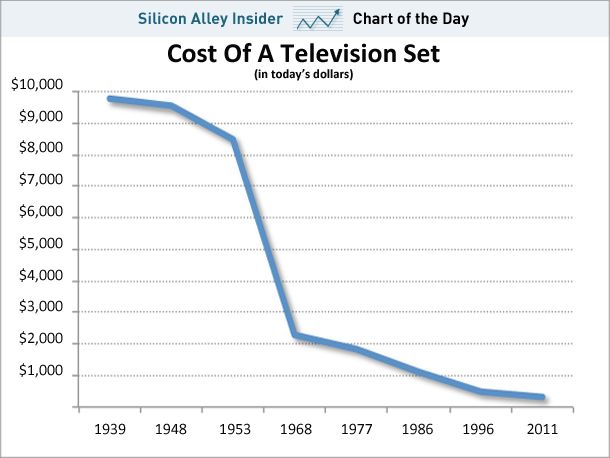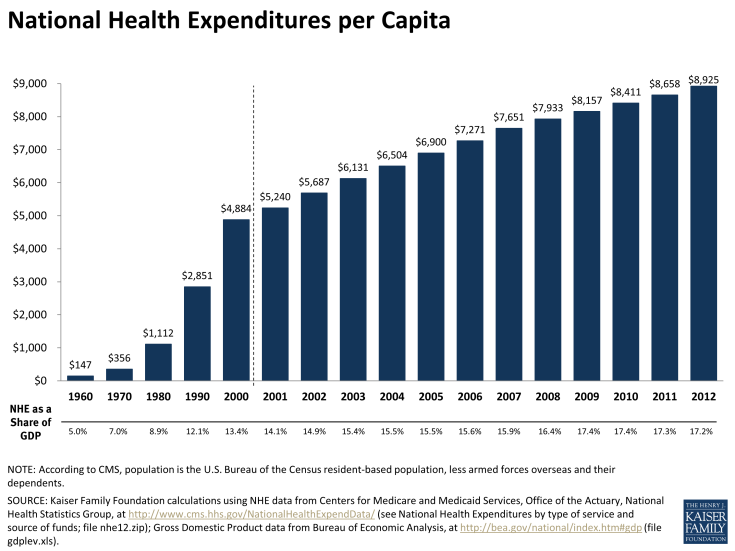How would you like to spend $10,000 on a new television? Before you walk away, let me tell you what you’d be getting: An enormous 22 inch screen. Faded color. And with three channels to choose from, I guarantee you’ll only run out of things to watch half of the time! Wait! Where are you going? You don’t want to spend $10,000 on a new television? Then you wouldn’t have liked 1954. The first mass produced televisions cost $1000 in 1954 dollars. Adjusted for inflation, that’s $9,097.88 in 2017 dollars.
Let’s fast forward to today: For $160 I can have a brand new 32 inch Smart Hd Tv shipped right to my front door. Not $160 in 1954 dollars. $160 today. And for that $160, what do I get? Wi-fi enabled television. I can connect to Amazon Prime Streaming, Netflix, or Hulu for $8 a month. If I don’t want to pay, there are plenty of free services like Youtube I can watch for entertainment.
http://www.businessinsider.com/chart-of-the-day-the-incredibly-shrinking-price-of-tvs-2011-12
Since their invention, Televisions have gotten exponentially better while plummeting in price. But maybe I don’t want a television. Maybe I’m on the go and I need a way to watch my content on the go. I have a couple of options:
One of the first successful personal computers was the Apple II, in 1977. The cheapest option had 4KB of RAM for $1298. In 2017 dollars, that’s $5,221.24. My own laptop was $249 in October of 2015. It has 4GB of RAM and 1TB of hard drive space. I can produce podcasts, stream HD movies, play online games over wireless internet, and of course: write this blog post without even putting the smallest strain on it. But maybe you want something more compact.
The first commercial mobile phone was large, clunky, heavy, barely made a phone call, and was sold for $3,995 in 1983. In 2017 dollars, that would be $9,709.12. I bought my smartphone a year ago for $99.99. I can watch a video on youtube, while talking to someone in India, and texting a friend who lives in England all at once. My smartphone has more computing power than it took to get men on the moon and it fits into my pocket.
In the mostly free market we have for it, new technology has gotten exponentially better, and continues to do so every year, while costs are driven down and down until almost everyone can afford it. It’s a beautiful thing.
But there is an ugly side: Even though most medical innovation is driven by new technology, the cost of healthcare in the US has skyrocketed at a rate much higher than the rate of inflation.
Adjusted for inflation, that $147 a year in 1960 would be only $1,227.84 in 2017 dollars. But as you can see in the graph above, per capita spending on healthcare has risen at eight times more than the rate of inflation. Now, a decent rebuttal to this would be “Healthcare has gotten better. New medicines to combat more diseases. New devices that allow us to better treat a patient. It much more than you could ever hope for in 1960.” And, for the most part, I wouldn’t disagree with you. However, I believe I have proven that technological improvements only drive costs down. So what is different about healthcare? Government interference.
I’ll explain more in Pt.2 of “Say It With Me: Television is a Right!”
-David Rohde


